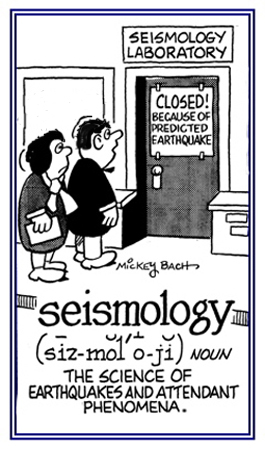seismo-, seism-, -seism, -seisms, -seisma, -seismically, -seismical, -seismal, -seismic
(Greek: to move back and forth; to shake, to move violently; earthquake)
seismographer
A specialist in the field of seismology.
seismography, seismographic
1. The descriptive science of earthquakes; also, the use of the seismograph in recording disturbances on the crust of the earth.
2. The scientific measuring and recording of the shock and vibrations of earthquakes; seismology.
2. The scientific measuring and recording of the shock and vibrations of earthquakes; seismology.
seismological
Of or pertaining to seismology.
seismologist
A specialist in the science of earthquakes and their effects.
seismologue
A catalogue of earthquake observations; a detailed account of earthquake phenomena.
1. The branch of geology that involves the studies of earthquakes and their effects on the areas of the earth: Joseph is a specialist of seismology who presents information regarding the locations and magnitudes of the trembles when they happen.
2. Etymology: from Greek seismo-, "a shaking" + -ology, "study of" or "science of".

© ALL rights are reserved.
Go to this Word A Day Revisited Index
2. Etymology: from Greek seismo-, "a shaking" + -ology, "study of" or "science of".

Go to this Word A Day Revisited Index
so you can see more of Mickey Bach's cartoons.
seismometer, seismometry
1. A tool for measuring earthquakes and attendant phenomena; such as, earth tremors or ground movement.
2. A special seismograph equipped to measure the actual movement of the ground.
2. A special seismograph equipped to measure the actual movement of the ground.
See seismograph in this listing for more details.
seismonasty, seismonastic, seismonic
1. Characterized by mechanical shocks or vibrations.
2. A growth movement of a plant in response to a non-directional shock or mechanical vibration stimulus.
2. A growth movement of a plant in response to a non-directional shock or mechanical vibration stimulus.
Seismosaurus
An “earth-shaking (or earthquake) lizard” from Late Jurassic New Mexico, USA. Named by U. S. paleontologist David Gillette in 1991.
seismoscope, seismoscopic
A simple form of seismometer; a contrivance for detecting or indicating the occurrence of an earthquake shock, sometimes also indicating (without measuring) the intensity or direction of the earthquake waves.
seismostratigraphy
Seismic data which allow researchers to measure the temperature at the boundary between the earth's core and the outer mantle.
seismotactic, seismotaxis
A directed response of a motile organism to mechanical vibration or a shock stimuli.
seismotectonic
1. Of, pertaining to, or designating features of the earth’s crust; such as faults, which are associated with or revealed by earthquakes.
2. Designating or pertaining to structural features of the earth that are associated with, or revealed by, earthquakes.
2. Designating or pertaining to structural features of the earth that are associated with, or revealed by, earthquakes.
seismotherapy
1. Very rapid tapping of the surface effected by using an instrument, usually with an elastic tip.
2. The treatment of disease by vibration, as by vibratory massage.
3. The treatment of illness with mechanical vibrations.
2. The treatment of disease by vibration, as by vibratory massage.
3. The treatment of illness with mechanical vibrations.
seismotropic, seismotropism
An orientation response to mechanical vibration or a shock stimulus.
Here is a perspective about the history of earthquakes.
Related "move, motion" word units: cine-; kine-; mobil-; mot-, mov-; oscillo-; vibro-.


